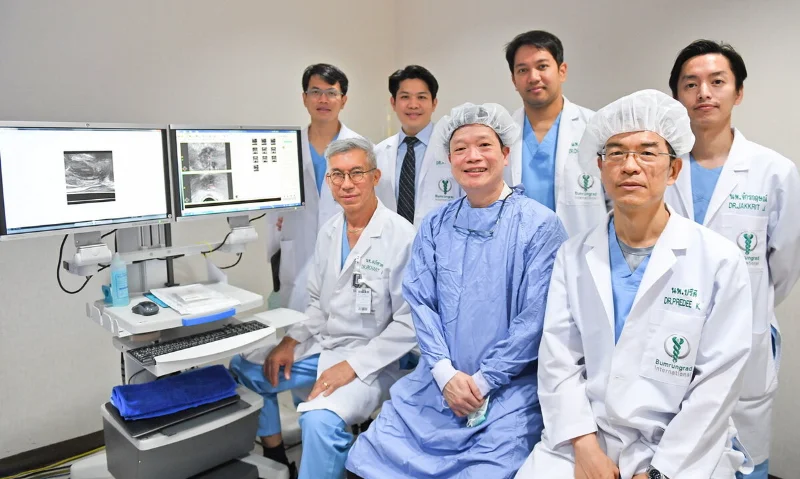Prostate cancer is the 4th most common cancer affecting men. According to Thailand’s National Cancer Institute, over 3,700 new cases of prostate cancer are seen each year and the Ministry of Public Health reports that prostate cancer causes 1,700 deaths annually. However, what worries researchers is the upward trajectory of both new cases and deaths related prostate cancer due to the aging of Thailand’s population. The situation is challenging to the medical community, which needs to increase the speed at which better treatments are developed so that patients experience a higher quality of life.

Dr. Teerapon Amornvesukit, Urology Specialist (Genito-Urinary) at Bumrungrad International Hospital states that “presently, we do not know the precise cause of prostate cancer, though we know the primary risk factor is age – the older you are, the greater the risk. Most cases develop in patients who are 50 years of age or older. Additionally, genetics play a role because people with a family history of prostate cancer will be at greater risk than those without. Also, national origin may be another factor, as prostate cancer is more common in European and American men. In the early stages of prostate cancer, there may be few to no symptoms. However, as the cancer grows it presses on the urethra, causing frequent urination, burning or pain during urination, incomplete bladder evacuation, weak stream during urination, difficulty urinating, or bloody urine.
The Bumrungrad Hospital Urology Center can treat prostate related conditions, including prostate cancer and enlarged prostate and employs the latest technology and medical innovations to do so. Cutting edge treatments improve treatment efficacy, as was the case in our pioneering use of water vapor therapy because we were the first to successfully perform it in Thailand. Water vapor therapy improved upon previous prostate treatments because it is safer, lower-risk, less complex, less invasive, and brings with it faster recovery times. In the past 18 months, the Urology Center has performed water vapor therapy on over 200 cases – one of the highest case-loads in Asia. Moreover, the Urology Center makes use of the modern robotic Da Vinci surgical system to treat certain prostate cancers. The Da Vinci robotic arm can rotate and grasp in 7 directions. Doctors control the robotic arm via 3-D imaging, making the procedure highly efficient and safe – helping to reduce post operative complications while making use of a reduced incision length, which reduces operative blood loss, and decreases recovery times.
“The Bumrungrad Hospital Urology Center successfully treats a wide variety of ailments and differentiates itself through the use of cutting-edge technology and treatments and the relentless pursuit of excellence. Toward that end, we are the first hospital in Thailand to make use of hydrogel spacer technology, which reduce complications arising from radiotherapy and brachytherapy for prostate cancer and increases patient quality of life. The first case to take advantage of the hydrogel spacer technology was treated this past March”, states Dr. Teerapon.
Dr. Teerapon also shared that in addition to surgical interventions for prostate cancer which employ the Da Vinci surgical system, radiation therapy is a common prostate cancer treatment. In any case, radiation therapy will also affect rectal tissue near the prostate during treatment, causing rectal inflammation, diarrhea, bloody stool. In some cases, the side effects of radiation therapy include constipation, which can result in severe pain and bleeding. The side effects of radiation therapy can happen immediately, 5 to 10 years post treatment, or even continue long-term. The use of hydrogel spacers can help prevent the side effects of radiation therapy for prostate cancer from ever happening in the first place.

Hydrogel spacers are made of polyethelene glycol, which is a material that is safe for surgery and will, over time, be absorbed and eliminated by the body. Doctors will inject the hydrogel into patients prior to prostate cancer radiation therapy between the rectum and prostate to increase the space between them, preventing or reducing the rectal absorption of radiation. Hydrogel insertion takes only 15 to 20 minutes, and the hydrogel spacer will hold its form for about 3 months before typically being absorbed by the body in 3 – 6 months.
Hydrogel insertion is a safe procedure, which has been performed successfully in the United States in over 200,000 cases. Research on the use of hydrogel spacers shows that the use of hydrogel spacers in prostate cancer patients treated with radiation therapy reduces rectal exposure to radiation by over 60% and it reduces the rate and severity of complications from radiotherapy and brachytherapy by over 70%. Further, some patients may experience an improvement in urinary and sexual function as well.
“Research results give us great confidence to offer hydrogel spacers to our patients. Our expert team of doctors all have received certificates in the technology as well as specialized training. We also practice integrated medicine using a team-based approach, with our urology and radiation therapy teams in close collaboration. Offering hydrogel spacers is just another way we show our lasting diligence and dedication to bring the cutting-edge medical interventions to our patients to increase the quality of treatment outcomes. We closely monitor international treatment trends so that we can continue to bring such innovations to our patients into the future as well”, said Dr. Teerapon.
The Bumrungrad Urology Center has teams of experienced physicians and urologists, who are ready to deliver holistic, effective treatments, which yield the best outcome for improved quality of life of our patients.
For more information, please contact the Bumrungrad Urology Center, Building A (Clinic), or call +662066 8888, +6661 409 3943 or 1378.



